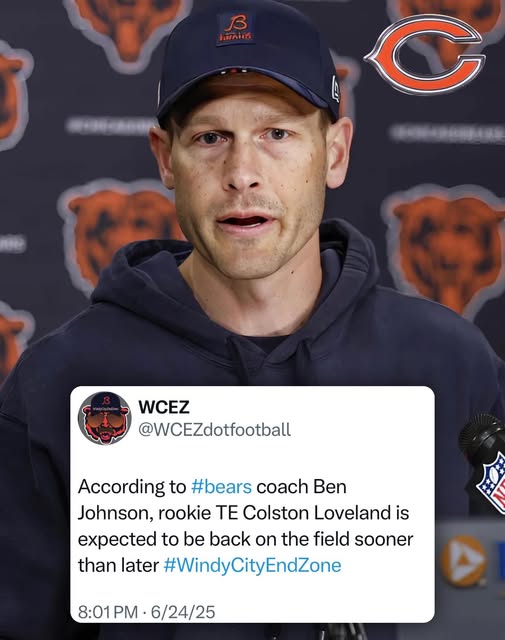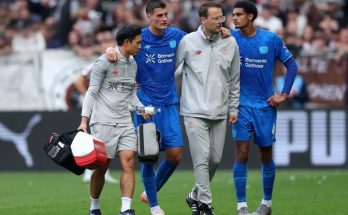Colston Loveland, one of the most promising tight ends in college football, is expected to return to action sooner than originally anticipated, giving a significant boost to his team’s offensive arsenal. This news comes as a welcome surprise to fans and analysts alike, who have been closely monitoring his recovery timeline following his recent injury. Loveland’s early return could play a critical role in shaping the course of the upcoming season, not only for his team’s immediate performance but also for his own long-term football trajectory.
Loveland, known for his combination of size, speed, and athleticism, quickly made a name for himself as a reliable target and a physical mismatch against opposing defenses. Since stepping into the spotlight, he’s earned praise for his route running, soft hands, and ability to create yards after the catch. His production and presence have made him a centerpiece in the offensive playbook, and his absence during injury was immediately felt. His potential return ahead of schedule has reinvigorated expectations around what the offense can accomplish in the coming weeks.
The tight end position is often underrated in terms of importance, but in modern offenses—especially those reliant on play-action, short-yardage success, and intermediate passing—it can be a game-changer. Loveland fits perfectly into that mold. His ability to stretch the field vertically and block on the line of scrimmage allows offensive coordinators to disguise plays and keep defenses guessing. The versatility he brings is rare, and it’s one of the reasons his early return is seen as a strategic advantage.
Though the exact nature of his injury wasn’t initially disclosed in great detail, reports suggested it was not season-ending but did require careful management to avoid further complications. During his recovery, the coaching staff and medical team have been conservative, ensuring he didn’t rush the healing process. They’ve also been proactive in integrating rehabilitation into his daily routine, helping him maintain conditioning and football IQ while staying off the field. Loveland’s personal commitment to recovery has also been highlighted as a key factor in his quicker-than-expected progress. He’s been described as diligent, focused, and fully engaged in both mental reps and physical therapy.
There is also the psychological aspect of injury recovery to consider, especially for a player with such high aspirations. For young athletes, especially those with potential NFL futures, injuries can be mentally taxing. Maintaining focus, avoiding discouragement, and staying motivated during a rehabilitation phase is a challenge in itself. By all accounts, Loveland has handled this period with maturity and resilience, staying engaged with teammates, attending practices, and contributing to meetings and game prep as much as possible. This kind of involvement not only accelerates mental readiness but fosters leadership qualities that are valuable both on and off the field.
With Loveland’s return imminent, there are several key implications to explore. For one, his presence will force defenses to account for another major threat. Defenses that have been stacking the box or doubling outside receivers may now have to adjust to account for the mismatch that Loveland creates in the middle of the field. He’s too fast for most linebackers and too big for most safeties, and that kind of matchup nightmare opens up opportunities for other offensive weapons. Whether it’s helping the run game by keeping defenders honest, or giving quarterbacks a security blanket in high-pressure situations, Loveland’s impact is multidimensional.
Moreover, his return will help stabilize offensive rhythm. During his absence, there were noticeable inconsistencies in short-yardage conversions and red-zone efficiency. Tight ends often serve as critical targets in those areas, and Loveland’s familiarity with the playbook, combined with his rapport with the quarterback, brings back a sense of continuity. Timing, trust, and chemistry are difficult to develop mid-season with backups or replacements, no matter how talented. Loveland’s return means the offense can get back to operating at its intended pace and precision.
There’s also a ripple effect when a player of Loveland’s caliber returns. His leadership, both vocal and by example, elevates the performance of those around him. Younger tight ends and receivers can learn from his work ethic and technique, while offensive linemen and quarterbacks gain confidence knowing he’s in the mix. That confidence permeates through the team and can lead to more aggressive play-calling, sharper execution, and a renewed sense of momentum.
In terms of individual trajectory, this early return keeps Loveland on track for continued development and exposure—both essential for his future prospects. NFL scouts and evaluators place a heavy emphasis on durability and availability, alongside athleticism and production. By returning to the field sooner than expected, Loveland not only demonstrates physical resilience but also a strong competitive drive, traits that are highly valued at the next level. Each game he plays from this point forward adds to his tape, builds his resume, and increases his visibility on draft boards.
That being said, it’s likely that the coaching staff will ease him back into full action rather than thrusting him into an all-out workload from the first snap. A gradual return is often the smartest path, ensuring the injury doesn’t flare up and that his body fully readjusts to game speed. Even in a limited role, Loveland’s presence will have a tangible impact. As he re-acclimates and regains full form, expect his snap count and role to expand steadily, possibly peaking during the latter part of the season when stakes are highest.
Another element worth noting is how Loveland’s return could influence game planning going forward. The offensive staff can reintroduce packages and formations that were shelved during his absence. These could include two-tight end sets, more complex play-action schemes, and red-zone misdirection plays that rely on tight end motion and deception. Having access to the full playbook again enables the offense to become more unpredictable, which is critical as the season enters its final stretch and opponents have more film to study.
From a fan’s perspective, this news re-energizes excitement around the team’s potential. Injuries often deflate momentum and create uncertainty, but knowing a key player is coming back ahead of schedule can have the opposite effect. Ticket sales, media attention, and overall enthusiasm tend to spike when marquee players return. Loveland’s early comeback also sends a message to the fanbase about the team’s determination, cohesion, and readiness to contend, even in the face of adversity.
Behind the scenes, Loveland’s return is also a testament to the medical and training staff. Rehabilitation programs, especially in the high-pressure world of collegiate athletics, require detailed planning, open communication, and cutting-edge methods. The staff’s ability to guide Loveland through recovery efficiently and safely speaks to their professionalism and commitment. It also reinforces the trust between players and the team’s health personnel, which is critical for long-term athlete wellness.
As the season progresses, all eyes will be on how Loveland performs upon his return. Will he pick up right where he left off, or will there be a brief adjustment period? Regardless, his reintroduction into the lineup reshapes the team’s identity and reestablishes a key component of their offensive blueprint. The timing couldn’t be better either, as upcoming matchups will require precision, execution, and contributions from every playmaker available. Having Loveland back on the field puts the team in a much stronger position to navigate those challenges.
In the bigger picture, this story also highlights the unpredictable nature of sports. Injuries, recoveries, setbacks, and comebacks are all part of the narrative that fans, players, and coaches navigate every season. What defines a team—and a player—is not the absence caused by injury, but the resilience shown in the return. Loveland’s quicker-than-expected comeback offers a reminder of that truth and provides a fresh jolt of optimism just when the team needs it most.
With continued support, smart usage, and a healthy progression, Colston Loveland is poised not just to return—but to make a meaningful impact in the games that matter most. If his trajectory continues upward, this midseason comeback could ultimately be viewed as the turning point that propelled both him and his team toward a strong finish. The road ahead is still challenging, but with one of their key weapons back in the mix, the outlook just got a lot brighter.



